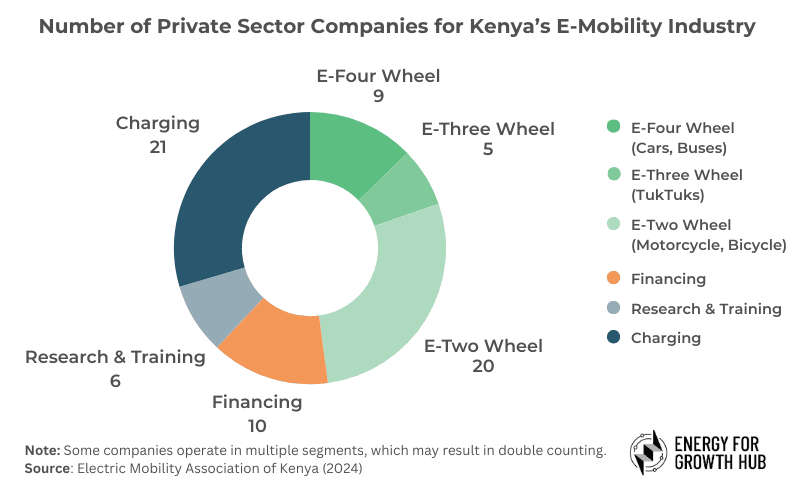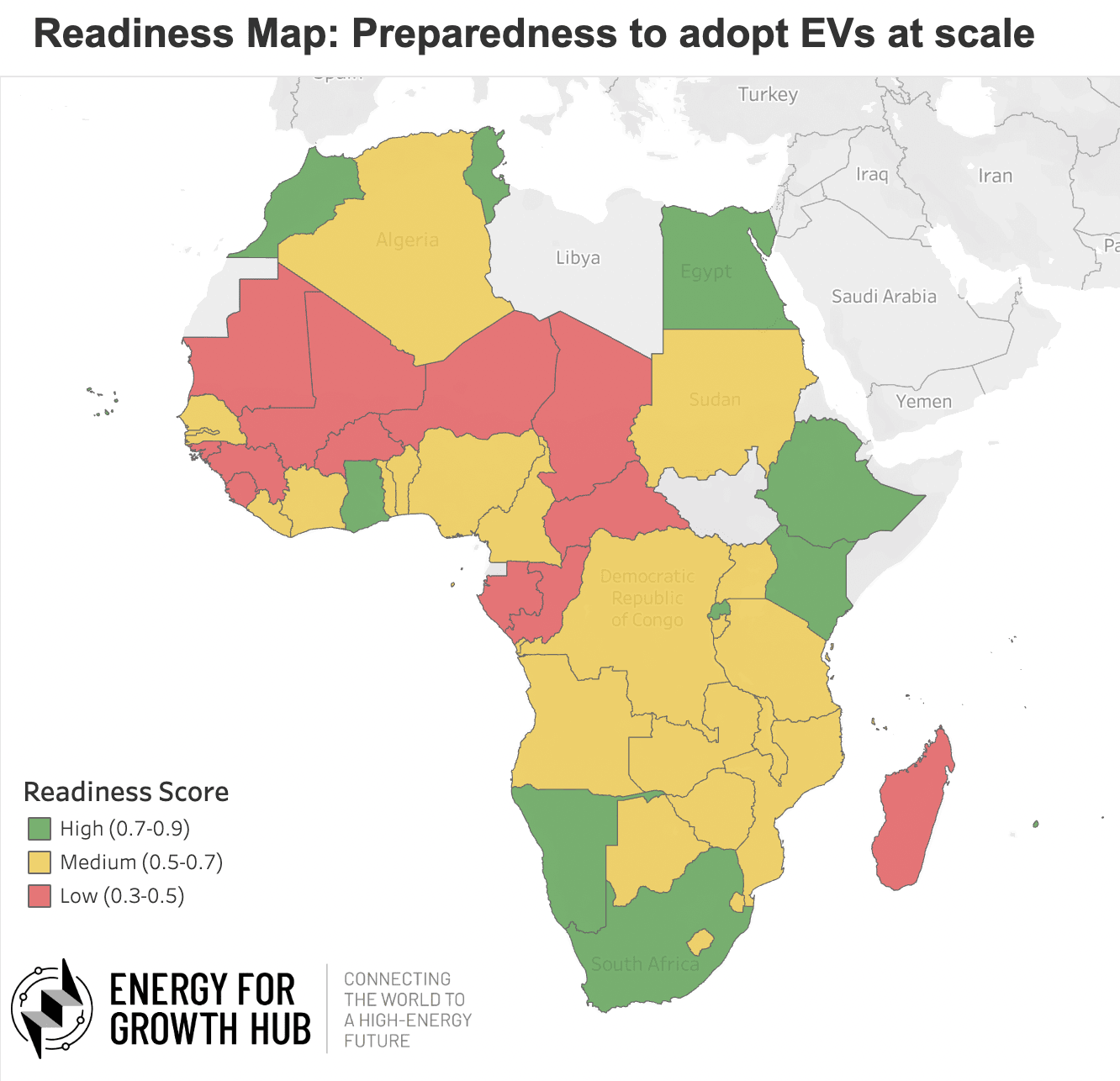Electric vehicles (EVs) are transforming global transportation, but Africa’s role in this revolution remains uncertain. Which African nations are ready to lead in EV adoption, and which risk falling behind? Our new Africa EV Readiness and Impact Index provides answers, and includes interactive maps showing continent-wide EV readiness and impact performance and a detailed methodology. This first-of-its-kind assessment analyzes data from over 48 African countries, measuring both EV readiness and potential benefits. Our findings reveal a diverse landscape — from countries emulating global EV trends to those pioneering innovative local solutions, as well as many still at the starting line.
12 countries in Africa are ready for EVs
Our research shows that 12 African countries demonstrate high readiness for EV adoption. These nations have shown promising progress in enabling policies, grid and charging infrastructure, and market conditions that support the transition to electric mobility.
A tale of three Africas
Our analysis reveals three distinct groups of countries when it comes to EV adoption in Africa:
- Emulators: Countries like Seychelles, Morocco, Mauritius, and South Africa are following adoption trends similar to more mature global markets. Our data shows that they have market and infrastructural conditions that closely resemble those of developed countries, including higher motorization rates, more mature power grids, and expanding public charging networks. These conditions enable EV adoption to progress through conventional pathways typically seen in more advanced markets, with a major focus on passenger vehicles, public charging infrastructure roll-out, and fleet electrification in both public transit and commercial sectors.
However, even these leading countries face challenges. Access to finance emerges as a notable weakness, with less than a fifth of the population over the age of 15 having borrowed from formal financial institutions or using mobile money accounts. This figure is as low as 5% in Morocco, a regional EV leader. Given the high upfront costs of EVs, improving access to financing will be crucial for accelerating adoption in these markets.
These high-readiness conventional adopters also have notably low impact scores compared to their market readiness scores. We define EV impact as the potential benefits of EV adoption across several indicators including carbon emissions, urban pollution, fossil import dependence and subsidy burdens, and power utility revenue generation. Low scores for these countries are primarily due to low clean power generation, modest share of transport carbon emissions, and milder air quality issues.
- Innovators: Countries like Kenya, Rwanda, and Uganda are pioneering innovative approaches to EV adoption, with a strong focus on two and three-wheeler electric vehicles. These nations are fostering a vibrant ecosystem of EV startups that are developing unique ownership, financing, and charging business models. Their progress is bolstered by supportive government policies and incentives — including EV penetration targets, tax exemptions, and preferential electricity tariffs — and a thriving fintech sector that enables experimentation with digital lending products for EVs.
Kenya exemplifies this innovative spirit, scoring highest in financial inclusion in our index with 40% of the population over 15 having borrowed from formal financial institutions or used mobile money accounts. This financial landscape has given rise to a dynamic asset fintech scene, with companies such as M-KOPA, and Watu Credit offering digital loans specifically for electric 2-wheelers. This dynamic ecosystem extends beyond fintech to encompass a diverse range of e-mobility players, as shown in the chart below. This variety of market participants across the EV value chain demonstrates Kenya’s emerging role as an e-mobility innovation hub in Africa.
Despite their innovative approaches, our data points to two significant challenges for these countries: weak grid infrastructure and constrained market conditions. Low per capita incomes have resulted in low motorization rates, which limits the potential size of the EV market. Simultaneously, unreliable electrical grids and insufficient grid capacity pose substantial hurdles for large-scale EV integration. These infrastructure and market limitations could potentially slow the pace of EV adoption, even as innovative business models and supportive policies drive progress in other areas. Policy uncertainty further complicates the landscape, as evidenced by Kenya and Uganda’s recent scaling back of EV tax incentives, though efforts to boost local assembly and manufacturing may help sustain momentum.

- Stragglers: Our analysis shows that the vast majority of African countries are lagging on EV readiness, facing multiple challenges across policy, infrastructure, and market readiness. The data paints a stark picture:
-
- Only 28% of countries have implemented at least one national EV target, and just 39% have established legally binding EV incentives.
- A mere 17% of African countries have 10 or more public charging stations.
- 76% of African countries have motorization rates below 100 vehicles per 1,000 people, far below the global average of 300 and the developing country average of 180.
- Financial inclusion lags, with only 13% of Africans over 15 having borrowed from a financial institution or mobile money account, compared to the global average of 30%.
- Grid reliability remains a significant hurdle, with only 8 African countries meeting high reliability standards.
However, this challenging landscape faced by the stragglers also presents a greenfield opportunity for EV development. Importantly, while many African countries lag in EV readiness, the region shows high potential for EV impact, particularly in improving urban air quality and reducing dependence on costly fossil fuel imports. Our analysis reveals a striking disparity: 24 countries demonstrate high EV impact potential, yet only 12 show high EV readiness. This gap underscores the need for less-ready countries to prioritize EV policies, given their potential in diverse areas of society. Investing in grid infrastructure is especially valuable, as it supports broader economic growth beyond just EVs. Additionally, countries can kick-start their EV sectors by introducing targeted tax incentives to promote EV adoption, as well as supporting public and private sector experiments such as fleet electrification pilots and incubating EV startups.
Countries to watch
Several countries stand out as particularly interesting cases in Africa’s EV landscape:
- South Africa: Watch for developments in power sector impacts on EV adoption due to the ongoing power sector crisis, as well as how its auto manufacturing industry — one of Africa’s largest — will manage a transition towards EV production.
- East African Innovators: Kenya, Rwanda, and Uganda are hotspots for EV startups, innovative business models, and pro-EV policies, especially in the two-wheeler segment. Although the scale has been modest so far, their vibrant and flourishing startup ecosystems position them as markets to monitor closely.
- Morocco: With its aggressive auto and EV manufacturing push, coupled with battery production ambitions and proximity to European markets, Morocco could become not just a regional but also a global EV powerhouse.
- Ethiopia: Ethiopia is positioning itself for wide-scale EV adoption through aggressive policies, including implementing a ban on all ICE vehicles, and expanding its power sector with mega projects such as the GERD dam. However, low motorization rates and incomes, inadequate grid and charging infrastructure, and uncertainty over implementation of its stringent policies present challenges to realizing these ambitions.
- Nigeria: As Africa’s third-largest economy, Nigeria presents a paradox in the EV landscape. Despite its economic heft, it lags in EV readiness with one of Africa’s most unreliable grids, below-average motorization rates, and minimal public charging infrastructure. However, Nigeria’s potential for EV impact is remarkably high. The country’s poor air quality, substantial (and contentious) fuel subsidy expenditures, and significant potential for utility revenues from EVs all contribute to its high EV impact score. This stark contrast between readiness and potential impact makes Nigeria a critical country to watch. Its vibrant tech ecosystem and growing EV startup scene, including notable players like MAX, hint at untapped potential. How Nigeria navigates these challenges and leverages its strengths could determine whether it emerges as a regional EV leader or remains a story of unfulfilled promise in Africa’s electric mobility future.
In conclusion, while Africa faces unique challenges in EV adoption, several countries are making significant strides. The continent’s diverse landscape of EV readiness and potential impact underscores the need for tailored strategies and policies to drive the electric mobility revolution across Africa.




